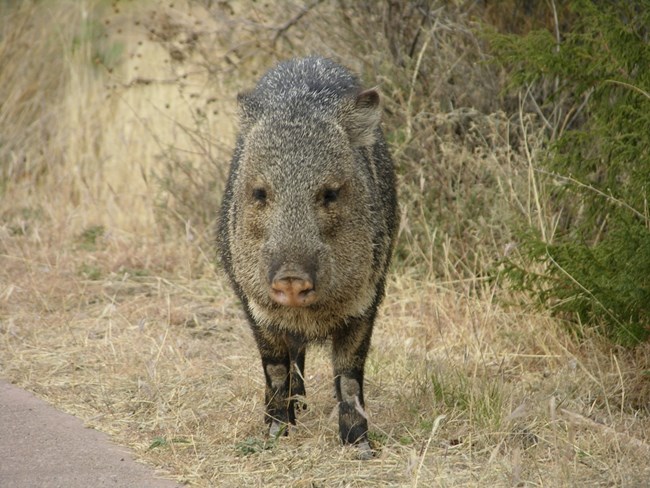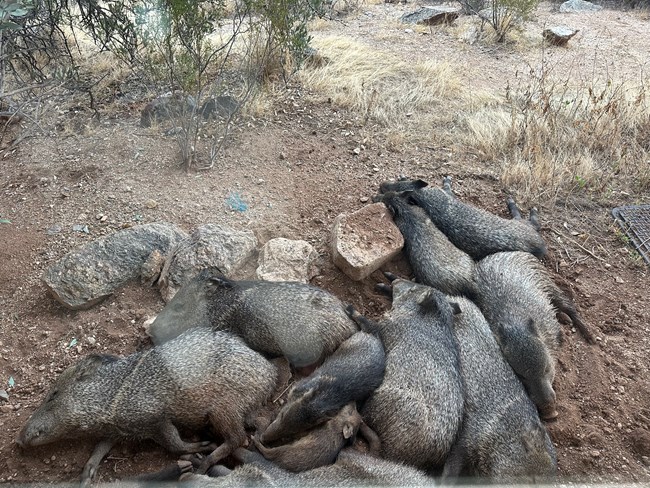"I am not a Pig!"Of all the fascinating animals in the Sonoran Desert, perhaps the most appealing is the javelina, also known as the collared peccary. Originally from Central America, javelinas migrated north into the southwestern United States about 250 years ago. Although javelinas may superficially resemble wild boars and domestic pigs, the peccaries are in a related, but far different animal family. 
NPS photo Collared Peccary (Pecari tajacu)Built low and close to the ground, javelinas stand about 18 inches tall and are between 32 and 36 inches long. An average adult weighs 40 to 60 pounds. They have four toes in the front and three in the back, but only two on each foot are hooves that commonly leave tracks. They have coarse salt-and-pepper fur with a band of white around the neck, giving teh appearance of a collar. A man of darker hair on the back of the neck and shoulders will bristle when the animal faces danger. Food and ShelterJavelinas are active during the cooler parts of the day; in the summer, this means early morning and early evening. They prefer large trees, caves and rocky overhangs to get away from the midday sun and to hide from predators. Chiefly vegetarian, javelinas feed on a variety of desert plants, cactus stems, pads and fruits, agave hearts, mesquie beans, jojoba nuts, roots an flowers. An occassional insect or bird egg may be added to the menu. One of the javelina's favorite foods is the prickly pear cactus. They use their sharp, two-inch canine teeth to shred and consume the pads, spines and all. (Sometimes they stomp on the cactus pads to flatten the spines before eating.) During the late summer, prickly pear fruits begin to ripen, and like many desert animals, javelinas eat them with a relish. Family MattersBabies may be born in any season after a gestation period of 5 months. Babies are usually born during the summer rainy season when food is more plentiful. Females can have two litters per year. Twins are most common, though a single baby or triplets are also possible. The babies weigh 1 pound at birth, and after the first day, they are able to walk and follow the herd. After nursing for eight weeks, they begin eating solid food. The reddish-brown babies are miniature versioins of their parents. They are very vocal as they follow the adults, grunting and squealing for food and attention. Javelinas and HumansSaguaro National Park preserves important Sonoran Desert habitat for a variety of animals, including many herds of javelinas. In the wild, javelinas have a natural fear of humans. When given the chance, they will run away if people get too close. If an animal feels cornered or is protecting its young, it can act aggressively toward people or their pets. If you come across a baby javelina that you think is abandoned, leave it! Most likey, the mother was frightened away by your approach. She will return to her youngster once you have gone. 
NPS Photo Seeing JavelinaViewing javelinas is best done from a distance. Binoculars will give you a close-up look; a camera with a telephoto lens will help you get that special picture. Although a number of places within the park are named after this critter (Javelina Wash, Javelina Rocks, Javelina picnic area), there is not one reliable place to encounter a herd of peccary. Like many desert animals, they are most commonly seen crossing the road. And, as crepuscular animals, they are most active in twilight near dawn and dusk. |
Last updated: December 15, 2023
